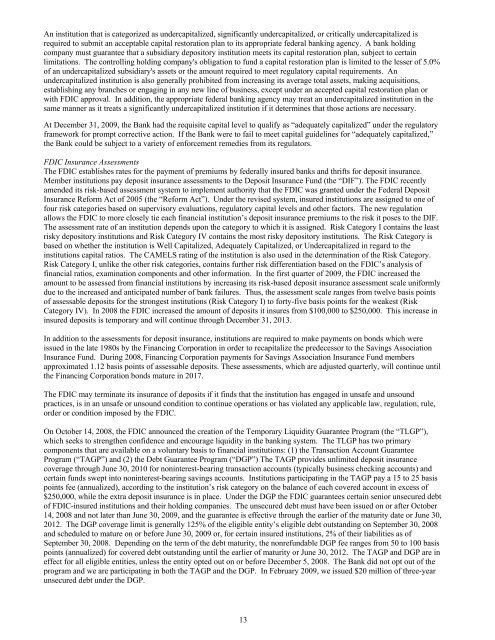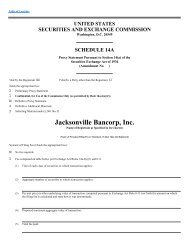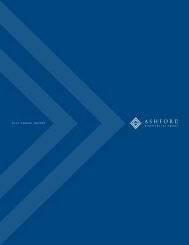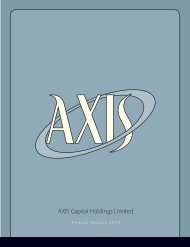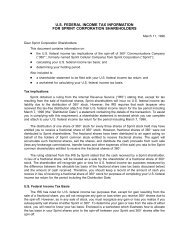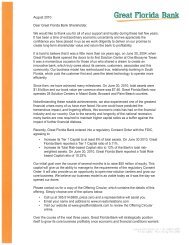pab bankshares, inc. - SNL Financial
pab bankshares, inc. - SNL Financial
pab bankshares, inc. - SNL Financial
Create successful ePaper yourself
Turn your PDF publications into a flip-book with our unique Google optimized e-Paper software.
An institution that is categorized as undercapitalized, significantly undercapitalized, or critically undercapitalized is<br />
required to submit an acceptable capital restoration plan to its appropriate federal banking agency. A bank holding<br />
company must guarantee that a subsidiary depository institution meets its capital restoration plan, subject to certain<br />
limitations. The controlling holding company's obligation to fund a capital restoration plan is limited to the lesser of 5.0%<br />
of an undercapitalized subsidiary's assets or the amount required to meet regulatory capital requirements. An<br />
undercapitalized institution is also generally prohibited from <strong>inc</strong>reasing its average total assets, making acquisitions,<br />
establishing any branches or engaging in any new line of business, except under an accepted capital restoration plan or<br />
with FDIC approval. In addition, the appropriate federal banking agency may treat an undercapitalized institution in the<br />
same manner as it treats a significantly undercapitalized institution if it determines that those actions are necessary.<br />
At December 31, 2009, the Bank had the requisite capital level to qualify as “adequately capitalized” under the regulatory<br />
framework for prompt corrective action. If the Bank were to fail to meet capital guidelines for “adequately capitalized,”<br />
the Bank could be subject to a variety of enforcement remedies from its regulators.<br />
FDIC Insurance Assessments<br />
The FDIC establishes rates for the payment of premiums by federally insured banks and thrifts for deposit insurance.<br />
Member institutions pay deposit insurance assessments to the Deposit Insurance Fund (the “DIF”). The FDIC recently<br />
amended its risk-based assessment system to implement authority that the FDIC was granted under the Federal Deposit<br />
Insurance Reform Act of 2005 (the “Reform Act”). Under the revised system, insured institutions are assigned to one of<br />
four risk categories based on supervisory evaluations, regulatory capital levels and other factors. The new regulation<br />
allows the FDIC to more closely tie each financial institution’s deposit insurance premiums to the risk it poses to the DIF.<br />
The assessment rate of an institution depends upon the category to which it is assigned. Risk Category I contains the least<br />
risky depository institutions and Risk Category IV contains the most risky depository institutions. The Risk Category is<br />
based on whether the institution is Well Capitalized, Adequately Capitalized, or Undercapitalized in regard to the<br />
institutions capital ratios. The CAMELS rating of the institution is also used in the determination of the Risk Category.<br />
Risk Category I, unlike the other risk categories, contains further risk differentiation based on the FDIC’s analysis of<br />
financial ratios, examination components and other information. In the first quarter of 2009, the FDIC <strong>inc</strong>reased the<br />
amount to be assessed from financial institutions by <strong>inc</strong>reasing its risk-based deposit insurance assessment scale uniformly<br />
due to the <strong>inc</strong>reased and anticipated number of bank failures. Thus, the assessment scale ranges from twelve basis points<br />
of assessable deposits for the strongest institutions (Risk Category I) to forty-five basis points for the weakest (Risk<br />
Category IV). In 2008 the FDIC <strong>inc</strong>reased the amount of deposits it insures from $100,000 to $250,000. This <strong>inc</strong>rease in<br />
insured deposits is temporary and will continue through December 31, 2013.<br />
In addition to the assessments for deposit insurance, institutions are required to make payments on bonds which were<br />
issued in the late 1980s by the Financing Corporation in order to recapitalize the predecessor to the Savings Association<br />
Insurance Fund. During 2008, Financing Corporation payments for Savings Association Insurance Fund members<br />
approximated 1.12 basis points of assessable deposits. These assessments, which are adjusted quarterly, will continue until<br />
the Financing Corporation bonds mature in 2017.<br />
The FDIC may terminate its insurance of deposits if it finds that the institution has engaged in unsafe and unsound<br />
practices, is in an unsafe or unsound condition to continue operations or has violated any applicable law, regulation, rule,<br />
order or condition imposed by the FDIC.<br />
On October 14, 2008, the FDIC announced the creation of the Temporary Liquidity Guarantee Program (the “TLGP”),<br />
which seeks to strengthen confidence and encourage liquidity in the banking system. The TLGP has two primary<br />
components that are available on a voluntary basis to financial institutions: (1) the Transaction Account Guarantee<br />
Program (“TAGP”) and (2) the Debt Guarantee Program (“DGP”) The TAGP provides unlimited deposit insurance<br />
coverage through June 30, 2010 for noninterest-bearing transaction accounts (typically business checking accounts) and<br />
certain funds swept into noninterest-bearing savings accounts. Institutions participating in the TAGP pay a 15 to 25 basis<br />
points fee (annualized), according to the institution’s risk category on the balance of each covered account in excess of<br />
$250,000, while the extra deposit insurance is in place. Under the DGP the FDIC guarantees certain senior unsecured debt<br />
of FDIC-insured institutions and their holding companies. The unsecured debt must have been issued on or after October<br />
14, 2008 and not later than June 30, 2009, and the guarantee is effective through the earlier of the maturity date or June 30,<br />
2012. The DGP coverage limit is generally 125% of the eligible entity’s eligible debt outstanding on September 30, 2008<br />
and scheduled to mature on or before June 30, 2009 or, for certain insured institutions, 2% of their liabilities as of<br />
September 30, 2008. Depending on the term of the debt maturity, the nonrefundable DGP fee ranges from 50 to 100 basis<br />
points (annualized) for covered debt outstanding until the earlier of maturity or June 30, 2012. The TAGP and DGP are in<br />
effect for all eligible entities, unless the entity opted out on or before December 5, 2008. The Bank did not opt out of the<br />
program and we are participating in both the TAGP and the DGP. In February 2009, we issued $20 million of three-year<br />
unsecured debt under the DGP.<br />
13


